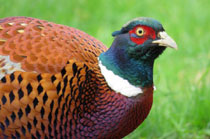



Pheasant Roadkill Peaks in Autumn and Late Winter
Chickens' motives for crossing the road are often questioned - but pheasants should probably avoid it altogether, new research suggests.
Researchers from the universities of Exeter and Cardiff compared roadkill figures from the 1960s and 2010s - before and after the start of mass release programmes of pheasants for shooting - and found pheasants remain disproportionately likely to be run over compared to other birds.
"There may be a number of reasons why pheasants are so commonly killed on the roads, including their short flight distances and relatively small brains," said Dr Joah Madden, of the University of Exeter.
"Our research shows that large-scale release of pheasants has not changed their likelihood of being killed, but it has changed the times of year when they are being killed."
The peak times of year for pheasant roadkill have changed from early summer in the 1960s to autumn and late winter now.
These twin peaks coincide with times in the year when captive-bred pheasants are released from pens, and when supplementary feeding ceases following the end of the shooting season.
"Pheasants in the 2010s are no longer susceptible during their June-August breeding season, unlike in the 1960s, perhaps because relatively few breed successfully," Dr Madden said.
"Instead, roadkill first peaks in September-November as pheasants disperse from release pens. It then declines over winter, but when supplementary feeding ceases in February, we see a second peak.
"Captive-bred pheasants may be at risk after release from pens because they have not learned survival skills.
"Being raised in the absence of parents, they simply lack the opportunity to learn."
Dr Madden, whose work was funded by the European Research Council, added: "Certain simple steps might help reduce pheasant roadkill, such as feeding them away from roads and continuing feeding them from February to May, after the shooting season has ended, to stop them wandering on to roads."
The researchers used roadkill figures from citizen science group Project Splatter, established and coordinated by Dr Sarah Perkins, of Cardiff University.
"Our work demonstrates how changes in animal behaviour can be revealed by roadkill data reported by members of the public, and the value of citizen science," Dr Perkins said.
Facts and figures:
- In 1960-61, the UK's estimated 200,000-1 million pheasants made up 0.1-0.5 per cent of the country's breeding bird population - but an estimated 6.8 per cent of all roadkill birds were pheasants (making them at least 13 times more likely to die on roads than would be expected if all birds had equal chances).
- By 2011, estimates suggested pheasant numbers ranged through the year from 5.6 million (3.6 per cent of total UK breeding birds in winter) to 28 million (7 per cent of total bird population) after the breeding season.
- Roadkill figures from 2013-16 gathered by Project Splatter suggest that pheasants remain disproportionately likely to be killed on roads - 5.4 times higher than their share of the population in winter, and almost 12 times higher after the breeding season. This likelihood is reduced when their large body size is accounted for, making them about 1.3-1.6 times more likely to die on roads than expected based on total body mass.
- Figures from 1999-2003 suggest 65 road accidents per year involved pheasants, and 6 per cent of these led to human deaths or serious injuries. The paper, published in the journal Royal Society Open Science, is entitled: "Why did the pheasant cross the road? Long-term road mortality patterns in relation to management changes."
October 2017








